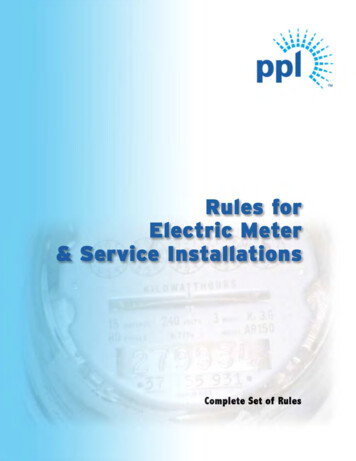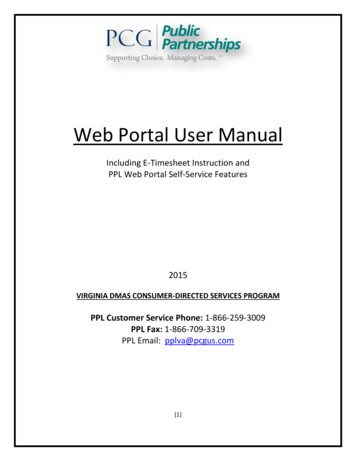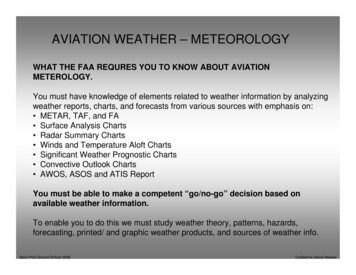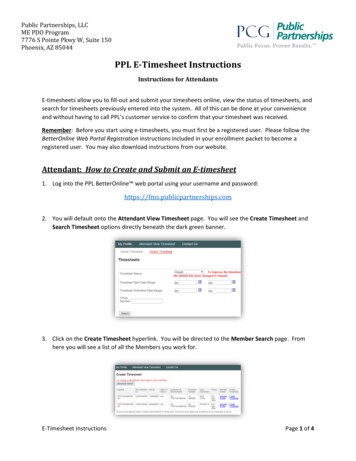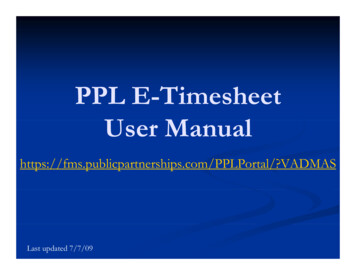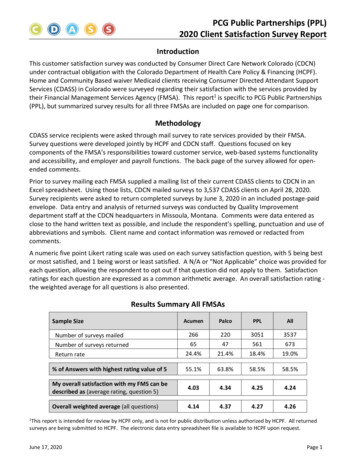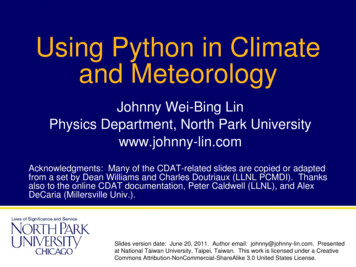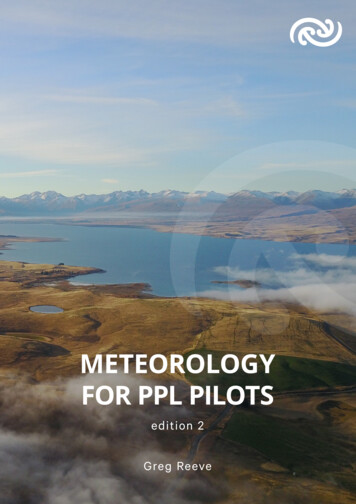
Transcription
Meteorology for PPL Pilots (Ed 2) Meteorological Service of New Zealand LtdMETEOROLOGYFOR PPL PILOTSedition 2Greg Reeve!1
Meteorology for PPL Pilots (Ed 2) Meteorological Service of New Zealand LtdSpecial thanks must go to Chris Webster, Meteorologist at MetService. His invaluable help in providing material andassisting with editing and peer reviewing this text is much appreciated.Thanks must also go to Tamara GnjidicVuksa, Aviation Meteorologist at MetService, for allowing me use some of her workon the new GRAFOR and GNZSIGWX products in this publication.I would also like to acknowledge Nicola Cornish, Multimedia Designer at MetService, for the many hours of work she hasdone in tidying up and formatting my work—Greg Reeve2
Meteorology for PPL Pilots (Ed 2) Meteorological Service of New Zealand Ltd Meteorological Service Of New Zealand Ltd 2018 All Rights Reserved.This book or any portion thereof may not be reproduced or used in any manner whatsoever without the express writtenpermission of the publisher.ISBN: 978-0-473-46065-5 (Epub)Meteorology for PPL pilots (2018)Contact:Greg Reeve, Meteorologist OhakeaEmail: Greg.Reeve@metservice.comPhone: (06) 351 5435Mobile: 027 551 54353
Meteorology for PPL Pilots (Ed 2) Meteorological Service of New Zealand LtdCONTENTSINTRODUCTION .5§8.2 Decode Domestic Meteorological Reports and Forecasts .6§8.4 Weather Maps. 32§8.6 The Atmosphere .39§8.8 Temperature and Heat Exchange Processes. 42§8.10 Atmospheric Pressure and Density .46§8.12 Wind .54§8.14 Local Winds . 66§8.16 Water Vapour .72§8.18 Atmospheric Stability .78§8.20 Inversions .84§8.22 Cloud .89§8.24 Precipitation .97§8.26 Visibility and Fog .100§8.28 Aircraft Icing .108§8.30 Thunderstorms. 113§8.32 Mountain Weather. 115§8.36 Airmasses and Fronts .123§8.40 Turbulence . 128§8.44 New Zealand Weather .135§8.50 Assess Satellite and Radar Imagery, and Non-Aviation-Specific Weather Information .137§8.52 Interpret Domestic Meteorological Services, Reports and Forecasts. 1444
Meteorology for PPL Pilots (Ed 2) Meteorological Service of New Zealand LtdINTRODUCTIONMetService NZ Ltd has produced this book on Meteorology for Private Pilot’s Licence. It is designed not only to help youpass your PPL Meteorology examination, but to give you the necessary tools to be able to make sound weather-baseddecisions in relation to your flying activities.The manual is comprised of twenty-one chapters set out in accordance with Subject No 8 PPL Meteorology syllabus asstated in the Civil Aviation Authority Advisory Circular AC61-3 as introduced by the CAA on November 24th, 2017Throughout this publication, reference is made to Southern Hemisphere examples; any references to NorthernHemisphere examples are largely ignored. The Northern Hemisphere is a mirror image of the Southern Hemisphere sowind directions etc. are reversed.MetService wishes you happy and safe flying!5
Meteorology for PPL Pilots (Ed 2) Meteorological Service of New Zealand Ltd§8.2 Decode Domestic Meteorological Reports and Forecasts8.2.2Demonstrate how to access avia3on meteorological informa3on for New Zealand through theMetFlight internet web-site.8.2.4In plain language, decode the informa3on contained in the following forecasts and I;(f)METAR AUTO;(g)GNZSIGWX;(h)ATIS;(i)AWIB;(j)BWR;(k)Pilot Reports;(l)AAW;(m)GSM8.2.2Demonstrate how to access avia3on meteorological informa3on for New Zealand through theMetFlight internet web-site.Access to the MetFlight GA internet-based web-site is free to all recreational pilots operating at or below 10,000ft,under VFR or IFR rules (please note, this web-site is only to be used for non-commercial purposes). To accessMetFlight, log on to:URL:hWp://meYlight.metra.co.nzUsername:your licence numberPassword:the ini3al grant date of your licence in the form d/mm/yyyyThe above instructions will work for most pilots, however there are a few variations, and these are explained byclicking on the ‘Help’ button once you have entered the login page of the MetFlight GA web-site.8.2.4In plain language, decode the informa3on contained in the following forecasts and reports:Please note: This objective, 8.2.4, is listed correctly at the beginning of this chapter, in accordancewith Subject No 8 PPL Meteorology, as stated in the Civil Aviation Authority Advisory Circular AC61-3.However, the AAW, GRAFOR, GNZSIGWX and GSM products should all be considered together whenplanning a cross country flight. Therefore, these products will be covered first, and consecutively (andconsequently, out of order) in this book to facilitate a better learning experience.The purpose of this topic is simply to decode meteorological forecasts and reports. Learning how tointerpret this decoded data is a different proposition altogether, and this is covered in chapter 8.52toward the end of this book.6
Meteorology for PPL Pilots (Ed 2)(l) Meteorological Service of New Zealand LtdAAW Aviation Area WindsIn MetFlight, Aviation Area Winds (and in fact, all of the forecasts and observations required for planning a crosscountry flight) are accessed by selecting the areas required for your planned flight from the map (see figure 1 below).After clicking on the ‘GET WEATHER BRIEFING’ button, the selected area winds, along with the current GRAFORmaps, the GNZSIGWX and GSM, plus TAFs and observational data will appear on the screen. ALL these productsshould then be considered together when planning for a cross-country flight.!Fig. 1 The Avia)on Area Wind Selec)on Map in MetFlight.7
Meteorology for PPL Pilots (Ed 2) Meteorological Service of New Zealand LtdThe AAW lists wind speed and direction (in knots and degrees true) at 1000, 3000, 5000, 7000 and 10000 feetAMSL. It also includes temperature forecasts (in degrees C) from 5000 feet upwards. Significant anticipated changesin either the forecast wind or the forecast temperatures will be shown to the right of the main listing under theappropriate time (UTC).!Fig. 2 An Example of the Aviation Area Wind Listing for the AL (Alps) Area.8
Meteorology for PPL Pilots (Ed 2)(a)GRAFOR Meteorological Service of New Zealand LtdGRaphical Aviation FORecast!Fig. 3 An Example of a GRAFOR for New Zealand.9
Meteorology for PPL Pilots (Ed 2) Meteorological Service of New Zealand LtdABTAboutABVAboveMONAbove MountainsAFTAfterAMDAmend/AmendedCOTAt the DGBuildingCLRClearBASECloud deteriorateEMBDEmbedded in a romIMPRImprovingVALIn cal/locally/location/locatedMTMountainMTWMountain WavesMOVMoving/MoveNSCNil Significant CloudNSWNil Significant attered10
Meteorology for PPL Pilots (Ed 2) Meteorological Service of New Zealand LtdSECTSectorSFCSurfaceTSThunderstormTLTill (followed by time by which weather change is forecast to end)TCUTowering hinFig. 4 Common Abbreviations Used in GRAFOR and GNZSIGWX Products.Explanation and decodeThe caption for each chart consists of a title/validity box and a disclaimer box. The disclaimer box is a reminder topilots about the implications of the use of CB in the chart and that heights are in feet AMSL. The disclaimer alsoreminds pilots to refer to the GNZSIGWX chart for occurrences of moderate turbulence and/or icing (along withseveral other moderate aviation hazards), and to refer to the GSM for any SIGMETs regarding severe events.!Fig. 5 An Example of a Title/Validity Box and a Disclaimer Box.If the chart is amended, the abbreviation AMD is inserted in the validity box and a remark box is added above thevalidity box to briefly explain why the amendment has been made, as highlighted below.!Fig. 6 An Example of the Title/Validity Box When the GRAFOR is Amended.GRAFOR forecasts contain sec oned off por ons of New Zealand where similar weather exists. In each weatherbox, the worst condi)ons expected are shown as follows: visibility, cloud layers below 10000ft AMSL, and weather.In addi on, spot freezing levels and the posi ons of fronts are included on the charts.11
Meteorology for PPL Pilots (Ed 2) Meteorological Service of New Zealand LtdGRAFOR products are issued overnight with three charts valid at 0600, 1200 and 1800 local. Another issue isproduced around mid-morning, with validities of 1200, 1800, and Midnight local. However, not all elements found onthe chart are valid at the time quoted. Some are valid at the spot time of the chart, while others are valid within 3hours of the stated fixed validity time. See ‘Chart Elements and Validities’ below.Chart Elements and Validi3esInformationSymbolDescription and unitsFreezing levelHundreds of feet AMSL.FixedvaliditytimeValidity 3h tofixed time ! !FrontsCold front!Warm front!Occluded front!Stationary front!Cloud/weatherareasDelineated by thick green lines(note: the black dots are thelocation of commonly usedaerodromes). !Cloud/weathergroupBox with cloud, weather andvisibility information, with anarrow pointing to the relevantchart area. !Non-deepconvective cloud!Described by amounts in oktas,with bases and tops (in hundredsof feet AMSL, as a single value ora range).Amounts can be:OVC – 8 oktasBKN – 5-7 oktasSCT – 3-4 oktasNSC – nil significant cloud (lessthan 3 oktas and/or bases higherthan 10,000 FT AMSL).12
Meteorology for PPL Pilots (Ed 2)Deep convectivecloud Meteorological Service of New Zealand LtdDescribed by spatial coverage:ISOL – area with maximum spatialcoverage up to 50%OCNL - area with maximumspatial coverage greater than 50%but less than 75%FRQ - area with maximum spatialcoverage greater than 75%EMBD can be added to indicatethat convective cloud isembedded in layers of other cloud. Type of cloud: TCU or CB.Bases and tops (in hundreds offeet AMSL, as a single value or arange). XXX means tops areabove 10,000 FT AMSL.Visibility andweatherPrevailing visibility with dominanttype of weather, along withdeterioration of conditions givenas the lowest visibility, the type ofweather that is causing it, and thelocation and timing of theoccurrence.If there isn’t any significantweather, abbreviation NSW (nilsignificant weather) will be used.Fig. 7 A Description of the Chart Elements and Validities Found in GRAFOR Products.13
Meteorology for PPL Pilots (Ed 2) Meteorological Service of New Zealand LtdSignificant Weather Elements used in GRAFORsQualifierWeather PhenomenaIntensity ‒ LightSH Shower(s)DZ DrizzleBR MistSQ SquallTS ThunderstormRA RainFG FogDR Low DriftingGS Small Hailand/or snowpelletsHZ HazeFC Funnelcloud(s)(Tornadoesor WaterSpouts)GR HailVA VolcanicAshModerate(no qualifier) HeavyBL BlowingFZ Freezing(Super-cooled)FU SmokeSN SnowSG Snow GrainsIC Ice Crystals(DiamondDust)DU WidespreadDustSA SandPO Dust/sandWhirls(dustdevils)SS SandstormDS Dust stormFig. 8 A List of Significant Weather Elements Found in GRAFOR Products.Note that this list is based on the significant weather types used in TAF and METAR (see Fig 13).Some examples of GRAFOR decodesInformation or symbolDecodeFreezing level: 8,500 FT AMSL.!!Freezing level: 11,500 FT AMSL.Cloud: 5-7 oktas with base at 2000 FT AMSL and top at 6000 FT AMSL.Visibility and weather: 30 KM in good conditions but reduced to 6000 M inshowers of rain in the eastern part of the delineated area.!Cloud: 5-7 oktas with base at 6500 FT AMSL and top ABV 10,000 FT.Visibility and weather: 30 KM, nil significant weather.!!!Cloud: 3-4 oktas with bases between 5000 and 7000 FT AMSL and tops ABV9000 FT AMSL.Visibility and weather: 25KM, light showers of rain can often be observed in thearea.Cloud: Nil significant.Visibility and weather: 35KM, nil significant weather.14
Meteorology for PPL Pilots (Ed 2) Meteorological Service of New Zealand LtdCloud: 5-7 oktas with bases between 1500 and 2500 FT AMSL, and tops ABV10,000 FT AMSL.Less than 50% of the area covered by embedded TCU with base 2000 FT AMSLand top ABV 10,000 FT AMSL.Visibility and weather: 20 KM, light rain can often be observed in the area;visibility reduced to 5000 M in rain within 50 NM of the front.!Cloud: Nil significant cloud.Visibility and weather: 500 M in fog, that will dissipate by 22Z.!!Cloud: 5-7 oktas with bases between 8000 and 10,000 FT AMSL, and tops ABV10,000 FT AMSL.Visibility and weather: 35KM, light showers of rain can often be observed in thearea.Cold front lying over southern Fiordland. Grey circle represents location ofManapouri Aerodrome (NZMO).!Fig. 9 Some Examples of Decoded GRAFOR Elements.15
Meteorology for PPL Pilots (Ed 2)(g)GNZSIGWX Meteorological Service of New Zealand LtdGraphical New Zealand SIGnificant WX (weather)!Fig. 10 An Example of a GNZSIGWX Chart.16
Meteorology for PPL Pilots (Ed 2) Meteorological Service of New Zealand LtdDecodes and/or explana3ons of the informa3on contained in the GNZSIGWX Chart in figure 10:Information or symbolDecode and/or ExplanationThe title box states the product name (GRAPHICAL NZ SIGWX), the heightthrough which the chart is valid (in this case from sea level to 10000ft AMSL),when the chart was issued (1954 UTC on 11th June 2018) and the periodthrough which the chart is valid (2100Z on the 11th to 1200Z on the 12th).!This is the disclaimer box which states that the chart is valid within the NZZCFIR only, that all heights are in feet AMSL (unless otherwise specified), thatthe use of the term CB implies severe turbulence and icing, and that pilotsshould refer to the GSM for any SIGMET information.!The legend box shows the symbols and shadings used to denote and explainthe presence of moderate hazards within the NZZC FIR (icing, turbulence,radio activity, volcanic ash, CB’s and mountain waves).Please note: the occurrences of severe hazards will not be shown on thischart. Instead, pilots must refer to the GSM for information regarding severephenomena.!Moderate turbulence forecast from sea level to a height above the upper levelof the chart.!!Moderate turbulence forecast above 10000ft AMSL in mountain waves. Theuse of the term ‘mountain waves’ implies the possibility of moderate to severeaircraft icing in the updrafting portion of the waves. If the forecaster believesthe icing may be significant, they will include an icing warning in this boxalong with the moderate turbulence indication.Moderate icing forecast above 7000ft AMSL, with the top of the icingcondition above the 10000ft upper limit of the chart. Icing conditionsimproving about and north of Auckland Airport from 0000Z.!Isolated embedded CB, bases 2000ft AMSL, tops above the upper limit of thechart. CB’s easing north of Gisborne from 0200Z.!Moderate icing forecast above 4000ft AMSL, with the top of the icingcondition above the 10000ft upper limit of the chart. The icing confined tothe area north of Timaru at first but spreading elsewhere by 0000Z.!Moderate turbulence forecast between the surface and 6000ft AMSL.!Fig. 11 Decodes and Explanations of the Information Contained in Figure 10.17
Meteorology for PPL Pilots (Ed 2)(m)GSM Meteorological Service of New Zealand LtdGraphical SIGMET MonitorSIGMET - SIGnificant METeorological information for pilots.SIGMETs are issued by MetService in both written and graphical form whenever the followinghazardous conditions are observed or forecast.SIGMETs are issued for:- Thunderstorms: obscured, embedded, frequent or in a squall line, with or without hail- Tropical cyclone- Severe turbulence- Severe icing – in cloud or due to freezing rain- Severe mountain waves- Heavy sandstorm or dust storms- Volcanic ash cloud and volcanic ejecta Each SIGMET is numbered consecutively and numbering is reset to SIGMET 01 at 0001 UTCdaily. Most SIGMETs are valid for FOUR hours but are reviewed after three hours. At that time, a newSIGMET is issued and the old one cancelled. This ensures continuity where an event lasts morethan 4 hours. SIGMETs for Tropical Cyclones and Volcanic Ash are valid for 6 hours and reviewed after 5hours. They also include an outlook (OTLK) for the TWELVE hours after the end of the sixhour period of the SIGMET, and the name of the TC or Volcano. Note that SIGMETs are not issued for isolated Cb clouds.There are two SIGMET areas in New Zealand: NZZC and NZZO (oceanic) corresponding to the FlightInformation Regions.The following abbreviations are used to indicate intensity changes:INTSFWKNNCintensifying,weakening,no change in intensity.18
Meteorology for PPL Pilots (Ed 2) Meteorological Service of New Zealand Ltd!!Fig. 12 An example of a Graphical SIGMET.19
Meteorology for PPL Pilots (Ed 2) Meteorological Service of New Zealand LtdDecodes of the SIGMETs shown in figure 12:SIGMET 29 (The red shaded area)NZZC SIGMET 29 VALID 221735/222135 NZKL-NZZC NEW ZEALAND FIR SEV TURB FCST WI S4550 E16530 S4250 E17020 - S4520 E17120 - S4800 E16810 - S4550 E16530SFC/FL120 STNR WKNNZZCwithin the NZZC FIRSIGMET 29SIGnificant METeorological information number 29 – the29th SIGMET or SIGMET cancellation issued since 0000 UTCon the 22nd of the month.221735/222135valid for the four-hour period from 1735 UTC on the 22nd to2135 UTC on the 22nd (UTC dates).NZKL –issued from the Kelburn Met Office in Wellington.NZZC NEW ZEALAND FIRfor the mainland, New Zealand Flight Information RegionSEV TURB FCSTsevere turbulence forecastWIwithin the polygon bounded byS4550 E16530 - S4250 E17020 - S4520 E17120 - S4800 E16810 - S4550 E16530lat/long pairsSFC/FL120between mean sea level and Flight Level 120 (12,000ft)AMSLSTNRthe polygon is stationaryWKNintensity weakeningSIGMETs 30 and 31 would have been cancellations of previously issued SIGMETs.20
Meteorology for PPL Pilots (Ed 2) Meteorological Service of New Zealand LtdSIGMET 32 (The spot point overhead Dunedin Airport)NZZC SIGMET 32 VALID 221954/222354 NZKLNZZC NEW ZEALAND FIR SEV ICE OBS AT 1944Z S4551 E17004 9000FT/FL110Severe Ice observed at 1944UTC (7.44 NZST on the 23rd day of the month) at position 45degrees 51 minutes south, 170 degrees 4 minutes east, between 9000ft and 11000ft AMSL.SIGMET 33 (The blue shaded area)NZZC SIGMET 33 VALID 221957/222357 NZKL-NZZC NEW ZEALAND FIR SEV ICE FCST WI S4630 E17030 S4600 E16940 - S4320 E17300 - S4340 E17400 - S4630 E170304000FT/FL120 MOV NE 15KT NCNZZCwithin the NZZC FIRSIGMET 33SIGnificant METeorological informa on number 33 – the33rd SIGMET or SIGMET cancella on issued since 0000 UTCon the 22nd of the month.221957/222357valid for the four-hour period from 1937 UTC on the 22nd to2357 UTC on the 22nd (UTC dates).NZKL –issued via the Kelburn Met Office in Wellington.NZZC NEW ZEALAND FIRfor the mainland, New Zealand Flight Informa on RegionSEV ICE FCSTsevere icing forecastWIwithin the polygon bounded byS4630 E17030 - S4600 E16940 - S4320 E17300 - S4340 E17400 - S4630 E17030lat/long pairs4000FT/FL120between 4000 above mean sea level and Flight Level 120(12,000 ) AMSLMOV NE 15KTthis polygon moving northeast at 15 knotsNCno change in intensity21
Meteorology for PPL Pilots (Ed 2)(b)TAF; Meteorological Service of New Zealand LtdTerminal Aerodrome ForecastForecast weather conditions within an 8-km radius of the aerodrome.All forecasts are issued in UTC time.There are two types of TAF available to GA; Domestic and International, valid for various time lengthsbetween about 12 hours (Domestic) and 24 hours (International).Domestic TAFs are issued overnight and updated again in the late morning.International TAFs are issued 4 times per day, approximately 1 hour prior to the start of the validity period.Amendments (AMD) are issued when the actual weather conditions vary markedly from the forecastconditions. (See Table GEN 3.5-4 of the AIP New Zealand Vol. 1, GEN 3.5 (Met Section) for amendmentcriteria).(c)TREND; A TREND forecastThese are appended to METAR, METAR AUTO or SPECI reports from Auckland, Wellington,Christchurch, Ohakea and Whenuapai aerodromes only. They are short term forecasts, valid for thetwo hours immediately following the issue time of the METAR, METAR AUTO or SPECI.This TREND forecast takes precedence over the TAF for the two-hour period of its validity.TRENDs and TAFs are forecasts of future weather and should be used when planning flights,especially cross country.(d)METAR; METeorological Aerodrome ReportMETAR are only issued from Whenuapai, Ohakea and Milford Sound airports. They are manuallyproduced routine reports of actual weather conditions. They are issued every hour, on the hourduring hours of ATC coverage, regardless of the state of the weather being reported, and theyinclude information on cloud within the whole visible sky. Times used are Co-Ordinated UniversalTime (UTC - French).(e)SPECI; SPECIal meteorological aerodrome report.SPECI are only issued from Whenuapai, Ohakea and Milford Sound airports. They are a manually producedreport of poor weather conditions, issued at times other than the top of the hour, when the weatherconditions deteriorate or improve past certain significant levels. To re-iterate, they can be issued at anystage during the hour, but not on the hour. On-the-hour reports will always be labelled as a METAR. SPECI'sare usually issued if there is a significant wind change OR if the cloud base reduces to 1500ft or lower ORvisibility reduces to/or below 8000m. All reports issued in UTC time.(f)METAR AUTO;METeorological Aerodrome Report, AUTOmatic.METAR AUTO are the dominant form of aerodrome report. They are routine weather reports in METARformat from an Automatic Weather Station (AWS). They are issued every half hour, 24 hours a day frommost aerodromes in New Zealand’s where scheduled passenger services occur. SPECI versions of METARAUTO reports are not issued. All reports are issued in UTC time.METAR AUTO, METAR and SPECI reports are just that – reports of conditions at the airfield at the time theobservation was produced. These reports become historical as soon as they are issued, and the more timegoes by, the older and less relevant they become. These reports should never be used as forecasts, unlessthe observation has a TREND forecast attached (see below for details).22
Meteorology for PPL Pilots (Ed 2) Meteorological Service of New Zealand LtdTerminology and Units used in TAF and TREND forecasts and in METAR AUTO, METAR and SPECI reports.Day of month Time:UTC (equivalent to GMT) – NZST is UTC 12 hours, NZDT is UTC 13 hoursWind:degrees TRUE, indicating the direction from which the wind is coming in KNOTS.Prevailing Visibility:Prevailing Visibility is defined as the maximum visibility covering at least halfthe horizon (note: individual sectors of the horizon can be added together tocomplete more than half of the total horizon). The rules for the InternationalAerodromes are slightly different from the other aerodromes in the country At NZAA, NZWN and NZCH only METRES up to 9999 metresAt all New Zealand aerodromes, apart from NZAA, NZWN and NZCH METRES up to 9999 metres, then Whole KILOMETRES above and including 10KM, up to 99KMWx Codes:Significant weather is designated by combinations of two-letter codes:For example:TS: ThunderstormSHRA: Moderate Shower of RainBCFG: Patches of FogFor a full list of weather codes used in reports and forecasts, see figure 13, later in this section.Cloud amounts are:SKCSKy Clear: 0/8ths, used at all aerodromes other than NZAA, NZWN and NZCHNSCNo Significant Cloud Cloud i.e. no cumulonimbus (Cb) or towering cumulus (TCu)observed at any height, and no other cloud below the highest minimum sector altitude,which is 5000ft at NZAA, 6500ft at NZWN, and 7000ft at OKCloud And Visibility OK. Visibility 10km or better, no cumulonimbus (Cb) ortowering cumulus (TCu) observed at any height. No other cloud below 5000ftor the highest minimum sector altitude, which is 5000ft at NZAA, 6500ft atNZWN, and 7000ft at NZCH. Used exclusively at NZAA, NZWN and NZCH.Cloud bases:Bases are given in hundreds of FEET above ground level (AGL) e.g.004 400ft AGL,020 2,000ft AGL,037 3700ft AGL,150 15,000ft AGL etc.Cloud types:Only Towering Cumulus (TCu) and Cumulonimbus (Cb) are reportedor forecast in METAR, SPECI, METAR AUTO, TAF and TRENDforecasts, e.g. “SCT020TCU” is “3-4/8 of Towering Cumulus, with abase of 2,000ft AGL”.Air Pressure:HECTOPASCALS (hPa) rounded down to the nearest whole hPa.NOSIG:‘NO SIGnificant change’ is expected to occur within the two-hour TRENDforecast period. METAR, SPECI and/or METAR AUTO reports from NZAA23
Meteorology for PPL Pilots (Ed 2) Meteorological Service of New Zealand Ltd(Auckland Intl), NZWN (Wellington Airport), NZCH Christchurch Intl), NZWP(Whenuapai) and NZOH (Ohakea) may be appended with this TREND. It indicates thatregardless of whether the reported weather is good or bad, it is expected toremain that way for the next 2 hours. So, if the ceiling and/or visibility are poorand the TREND says “NOSIG”, then conditions will remain poor (for the next twohours at least).TEMPO:TEMPOrary changes, each lasting less than 60-minutes during the specified timeframe, and where the temporary conditions are less dominant than the originalconditions forecast.BECMG:BECoMinG, where a permanent change is expected to take place graduallythroughout the period specified.PROB:PROBability that a phenomenon will occur. PROB is used if the phenomenon (e.g.TS, FG etc) has a 30% or 40% chance of occurring e.g. PROB40 FG.FM:FroMNSW:Nil Significant WeatherRE:REcentWS Rdrdr:WindShear on the designated Runway ‘drdr’, or WS ALL RWY:WindShear affecting all runways.RMK:REMarks in plain language appended to METAR or SPECI reports asrequired.AMD:AMenDed, as in TAF AMD, indicating that conditions have not turned out asforecast, and consequently the forecast has been changed.COR:CORrected, as in METAR COR, SPECI COR or TAF COR, indicating that an errorhas been made in the coding of the message, and the text has beencorrected (but not amended in the case of TAF COR).//:// is inserted into METAR AUTO reports in place of present weather when the sensor isunable to detect weather, either because there is no current ‘weather’ or because thecurrent weather condition is not detectable by the sensor (e.g. funnel clouds – FC –can’t be seen by present weather sensors).NCD:No Cloud Detected by the AWS. NCD inserted into a METAR AUTO reportindicates that the AWS cloud sensor has not registered any cloud. It does notnecessarily mean there is no cloud within the vicinity of the aerodrome.///:/// inserted at the end of the cloud groups in METAR AUTO reports indicatesthat the AWS cannot determine if the cloud types are Cb or TCu.////://// indicates that ‘visibility is not reported’ (probably due to a faulty sensor)./////////:///////// indicates ‘cloud is not reported’ (probably due to a faulty sensor).Oktas:Oktas is the phonetic pr
MetService NZ Ltd has produced this book on Meteorology for Private Pilot’s Licence. It is designed not only to help you pass your PPL Meteorology examination, but to give you the necessary to
